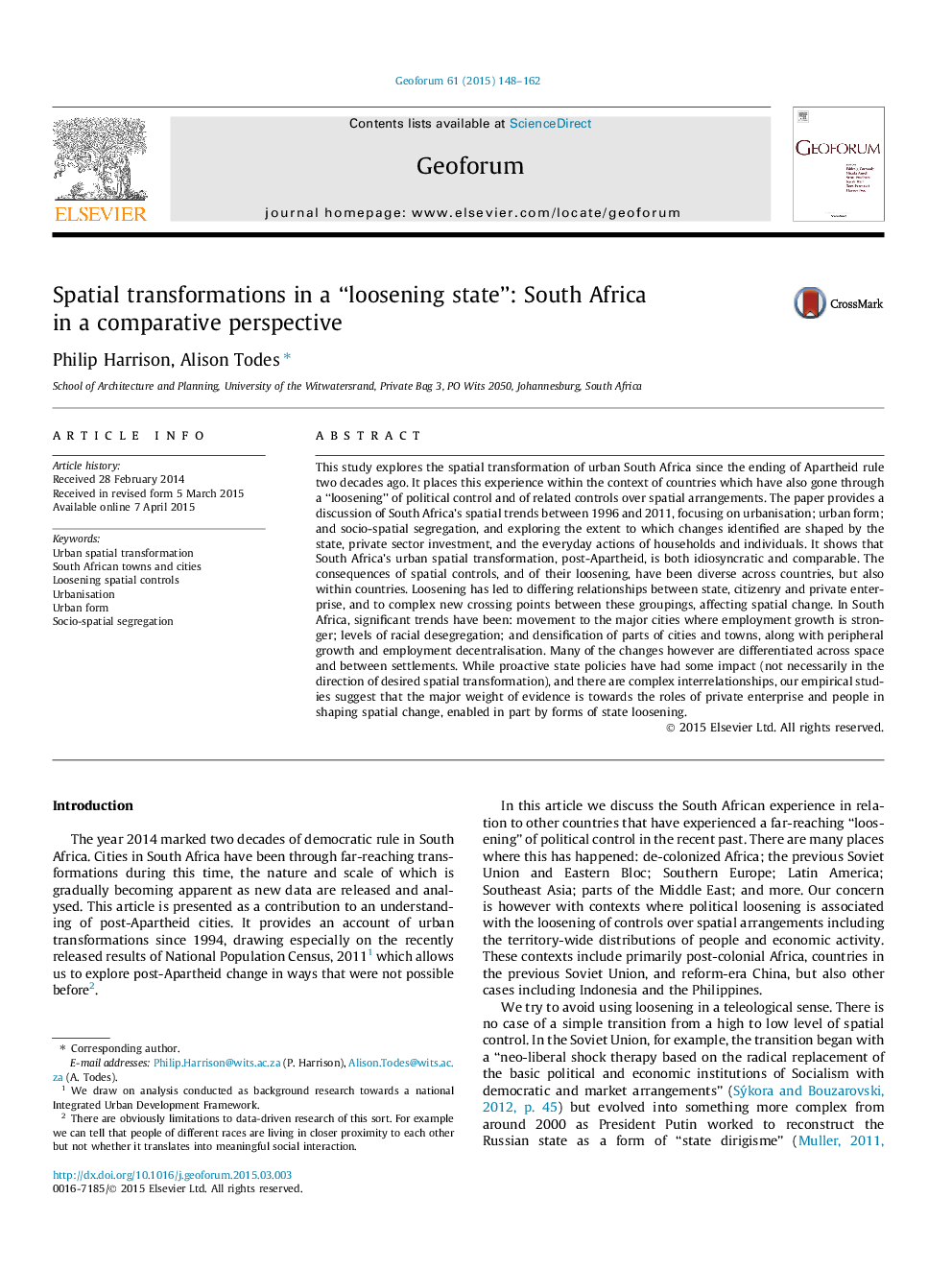| کد مقاله | کد نشریه | سال انتشار | مقاله انگلیسی | نسخه تمام متن |
|---|---|---|---|---|
| 5073779 | 1477128 | 2015 | 15 صفحه PDF | دانلود رایگان |
عنوان انگلیسی مقاله ISI
Spatial transformations in a “loosening state”: South Africa in a comparative perspective
ترجمه فارسی عنوان
تحولات فضایی در یک کشور ناامید کننده: آفریقای جنوبی در یک نگاه تطبیقی
دانلود مقاله + سفارش ترجمه
دانلود مقاله ISI انگلیسی
رایگان برای ایرانیان
کلمات کلیدی
تحول فضایی شهری، شهرهای و شهرهای آفریقای جنوبی، کنترل های مکانی فشرده، شهرنشینی، فرم شهری، جدایی اجتماعی و فضایی،
ترجمه چکیده
این مطالعه به بررسی تحول فضایی شهر آفریقای جنوبی از زمان پایان حکومت آپارتاید دو دهه پیش می پردازد. این تجربه را در زمینه کشورهایی قرار می دهد که از طریق یک لئونینگا نیز رفته اند؟ از کنترل سیاسی و کنترل های مربوط به ترتیبات فضایی. این مقاله یک بحث در مورد روند فضایی آفریقای جنوبی در سالهای 1996 تا 2011 را ارائه می دهد که تمرکز بر شهر سازی است؛ شکل شهری؛ و جداسازی اجتماعی و فضایی، و کشف میزان اینکه تغییرات شناسایی شده توسط دولت، سرمایه گذاری بخش خصوصی، و اقدامات روزمره خانوارها و افراد شکل گرفته است. این نشان می دهد که تحول فضایی شهری آفریقای جنوبی، بعد از آپارتاید، هم از لحاظ فردی و هم قابل مقایسه است. عواقب کنترل های فضایی و از دست دادن آنها در سراسر کشور، بلکه در داخل کشور، متنوع بوده است. خستگی منجر به ایجاد روابط متقابل بین دولت، شهروندی و شرکت های خصوصی و ایجاد پیچیدگی های جدید عبور بین این گروه ها شده است که بر تغییرات فضایی تأثیر می گذارد. در آفریقای جنوبی، روند قابل ملاحظه ای داشته است: حرکت به شهرهای اصلی که رشد اقتصادی قوی تر است؛ سطوح جداسازی نژادی؛ و تجمع بخشی از شهرها و شهرها، همراه با رشد محیطی و تمرکززدایی اشتغال. با این حال، بسیاری از تغییرات در فضا و بین شهرک ها متفاوت است. در حالیکه سیاست های دولتی مشارکتی تا حدودی تحت تاثیر قرار گرفته اند (لزوما در جهت تحول مکانی فضایی مورد نظر) و ارتباطات پیچیده ای وجود دارد، مطالعات تجربی ما نشان می دهد که وزن عمده شواهد در رابطه با نقش شرکت های خصوصی و مردم در شکل دادن تغییرات فضایی است، بخشی از آن توسط اشکال خشونت دولتی فعال می شود.
موضوعات مرتبط
علوم انسانی و اجتماعی
اقتصاد، اقتصادسنجی و امور مالی
اقتصاد و اقتصادسنجی
چکیده انگلیسی
This study explores the spatial transformation of urban South Africa since the ending of Apartheid rule two decades ago. It places this experience within the context of countries which have also gone through a “loosening” of political control and of related controls over spatial arrangements. The paper provides a discussion of South Africa's spatial trends between 1996 and 2011, focusing on urbanisation; urban form; and socio-spatial segregation, and exploring the extent to which changes identified are shaped by the state, private sector investment, and the everyday actions of households and individuals. It shows that South Africa's urban spatial transformation, post-Apartheid, is both idiosyncratic and comparable. The consequences of spatial controls, and of their loosening, have been diverse across countries, but also within countries. Loosening has led to differing relationships between state, citizenry and private enterprise, and to complex new crossing points between these groupings, affecting spatial change. In South Africa, significant trends have been: movement to the major cities where employment growth is stronger; levels of racial desegregation; and densification of parts of cities and towns, along with peripheral growth and employment decentralisation. Many of the changes however are differentiated across space and between settlements. While proactive state policies have had some impact (not necessarily in the direction of desired spatial transformation), and there are complex interrelationships, our empirical studies suggest that the major weight of evidence is towards the roles of private enterprise and people in shaping spatial change, enabled in part by forms of state loosening.
ناشر
Database: Elsevier - ScienceDirect (ساینس دایرکت)
Journal: Geoforum - Volume 61, May 2015, Pages 148-162
Journal: Geoforum - Volume 61, May 2015, Pages 148-162
نویسندگان
Philip Harrison, Alison Todes,
